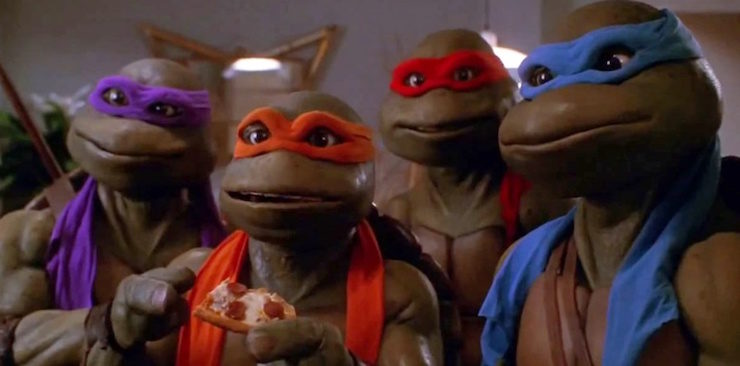The Teenage Mutant Ninja Turtles have been a phenomenon so long that probably nobody remembers that they started out as a parody of Marvel Comics of the 1980s, particularly those by Chris Claremont and Frank Miller.
Two of the biggest things in comics in the 1980s were teenage mutants (as seen in The X-Men and The New Mutants, written by Claremont) and ninjas (as seen in Daredevil and the Wolverine and Elektra miniseries, written and/or drawn by Miller). Kevin Eastman and Peter Laird created teenage mutants and also made them ninjas, and also turtles, and did them as a fairly straight black-and-white parody. (Daredevil is the primary source of parody here, as Splinter is a riff on DD’s mentor Stick, and the Foot is a play on the Hand. This has actually come full circle as a parody, since the Hand has become a major villain in Marvel’s various Netflix series.)
They became a huge multimedia hit, turned into a popular cartoon in 1987 and a series of live-action feature films in the 1990s.
The first film had trouble finding distribution, as the major studios were gun-shy of what they saw as a live-action adaptation of a kids’ cartoon (it was truly an adaptation of a comic, but Hollywood didn’t really acknowledge comics as a good source of movies back then once you got past Batman and Superman, and even they were better known for other screen versions). Previous attempts (Masters of the Universe, e.g.) had not been very successful.
So this little company called New Line Cinema, which mostly did B-movies and low-budget stuff, took it on. It started New Line on the path to respectability (they did Peter Jackson’s six Tolkien films), and they’re now a major studio.
The first film was a huge hit, and the sequel, subtitled The Secret of the Ooze, was released only a year later. Half the cast changed. Only two of the Turtle voices—Brian Tochi as Leonardo and Robbie Rist as Michelangelo—came back, with Adam Carl replacing Corey Feldman as Donatello and Laurie Faso replacing Josh Pais as Raphael. In addition, Paige Turco replaced Judith Hoag as April O’Neill, and the character of Casey Jones was dropped. The studio wanted to bring in Bebop and Rock Steady from the cartoon, but those characters didn’t originate in the comics, and the legal clearances to use them would’ve been more complicated, so they simply created Rahzar and Tokka as Shredder’s monsters.
Another change in the second film was that the Turtles used hand-to-hand combat more often than they used their signature weapons of swords, nunchucks, sais, and staff. This was apparently due to concerns about the violence in the first film. Why hitting people with your fists is inherently better than hitting them with a big wooden stick is unclear, but hey, America.
The Secret of the Ooze was also a hit, though its box office was smaller than the first, on a bigger budget. Two years later, the third film, which simply had a Roman numeral III attached with no subtitle, brought Elias Koteas back as Jones, kept Turco as O’Neill, brought back Feldman to voice Donatello, this time with Tim Kelleher as Raphael, and James Murray replaced Kevin Clash as the voice of the Turtles’ mentor Splinter. The diminishing returns of box office continued, as the third film was profitable, but less so than the other two (especially the first), and they decided to go out on a high note, with a discussed fourth film never getting out of the development phase.
A live-action TV series simply called Ninja Turtles came out for a season in 1997, and then the Turtles returned to the big screen in 2007 with an animated film simply called TMNT, with future Captain America/former Human Torch Chris Evans doing the voice of Jones, Sarah Michelle “Buffy” Gellar as O’Neill, and Sir Patrick Stewart his own self as Yaoti. A new set of live-action films debuted in 2014, with its sequel released in 2016 (we’ll be covering those down the line).
Not bad for a cute little thirty-year-old black-and-white parody comic, huh?
“God, I love being a turtle!”
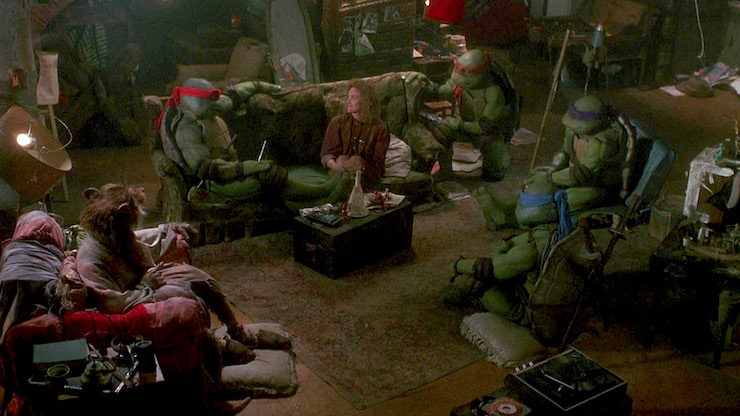
Teenage Mutant Ninja Turtles
Written by Bobby Herbeck and Todd W. Langen
Directed by Steve Barron
Produced by Kim Dawson, Simon Fields, & David Chan
Original release date: March 30, 1990
April O’Neill does a report for Channel 3 Eyewitness News about the crime wave that is sweeping New York City, as a rash of robberies has the police and the citizenry stymied. The victims never see the thieves.
When she heads home after a long day at the office, O’Neill sees thieves trying to steal stuff out of the Channel 3 news van. The gang starts to beat her up, but then a sai flies through the air and takes out the only streetlight. A minute later, the bad guys are all beat up and tied up, and O’Neill is safe. However, the sai that took out the street light is still on the sidewalk, and O’Neill grabs it.
O’Neill was saved by four human-sized turtles: Raphael (who wielded the sais, and who’s unhappy that he left one behind), Donatello, Leonardo, and Michelangelo. They go to their hideout in the sewer and report to their mentor, Splinter, a human-sized rat. While they act like typical teenagers, mostly, they are more respectful with Splinter—up to a point, anyhow. When he calls for meditation, they instead dance to the Champs’ “Tequila” (with the word “ninjitsu” substituted for the titular utterance).
Raphael, though, isn’t in a party mood, as he’s still grumpy about losing a sai, so he puts on a big hat and trenchcoat and goes to see a movie. On the way home, he stops a mugging, chasing the would-be thieves into Central Park, where he encounters a hockey-mask-wearing vigilante named Casey Jones. Raphael and Jones spar a bit, which lets the thieves get away.
O’Neill has heard from Japanese immigrants that this crime wave is very much like that perpetrated some time back in Japan by a mysterious group known only as “the Foot.” When O’Neill mentions this possibility on the air, she is chastised by both the chief of police and her boss.
Meanwhile, her boss’s son, Danny, is actually part of the Foot. An armored criminal called the Shredder has gathered a bunch of disaffected youths, trained them in martial arts and thievery, and is using them to build his criminal empire.
The Foot goes after O’Neill to warn her off the story, but Raphael saves her and brings her unconscious form back to their sewer hideout. Splinter provides their origin. He was the pet rat of Hamato Yoshi, a ninja warrior, and Splinter learned how to be a ninja from observing his human. After Yoshi was killed by a rival named Oroku Saki, Splinter scratched Saki’s face, while Saki cut off one of Splinter’s ears. Later, in the sewers of New York, Splinter came across a broken canister of ooze, which mutated him, as well as four baby turtles. Splinter raised the turtles to be ninja warriors.
That was fifteen years ago, and now they’re teenagers. Once O’Neill gets over her initial frightened confusion, she lets the turtles escort her back to her apartment, where they bond and enjoy each others’ company (and eat a lot of pork rinds).
However, one of the Foot ninjas followed Raphael and O’Neill back to the hideout, and they return in force and kidnap Splinter.
The turtles regroup at O’Neill’s apartment and try to figure out their next move. O’Neill’s boss visits with her son, and Danny catches glimpses of the turtles, intelligence he shares with Shredder and his lieutenant, Tatsu.
Raphael and Leonardo get into an argument, and Raphael goes to the roof to work out his frustrations. Jones sees him on the roof from another roof, and goes to investigate. The Foot also show up, and Raphael gets his butt kicked on the roof before they fall through the skylight. A massive fight ensues, which utterly trashes O’Neill’s home, as well as the antique shop she inherited from her father. Jones helps out, and they escape through a trapdoor. (During the fight, O’Neill’s boss leaves a message on her machine saying she’s fired.)
They take O’Neill’s van upstate to a family farm that hasn’t been occupied in years. Leonardo keeps watch over Raphael’s comatose form, while Jones and O’Neill either argue or flirt, depending on how you look at it. After Raphael awakens, the four turtles train together. Splinter manages to send them a vision, proving he’s alive, and they head back to the city.
Splinter is being held captive by the Shredder, though he has so far refused to tell the Foot anything. However, he does talk a lot with Danny, who is conflicted about his role with the Foot. We also find out that Shredder is actually Saki, and the helmet he wears as the Shredder is designed to cover the facial scars Splinter gave him.
Danny runs away to the turtles’ lair, telling O’Neill only that he ran away from home. He begs to stay the night. But while everyone else is sleeping, Danny sneaks back to Foot headquarters. Jones—who is claustrophobic, and therefore sleeps in the truck—sees this and follows him. Together they free Splinter and then lead the Foot teenagers back to the turtles’ home.
Meanwhile, Shredder leads a team of his ninjas to attack the turtles. While the quartet easily dispatch the thugs, they cannot defeat Shredder. However, Splinter confronts him, and is victorious, with Shredder falling into a garbage truck.
The turtles are victorious, and celebrate. O’Neill gets her job back, complete with raise and corner office. Splinter even makes a funny.
“Which one’s the ugly one?”
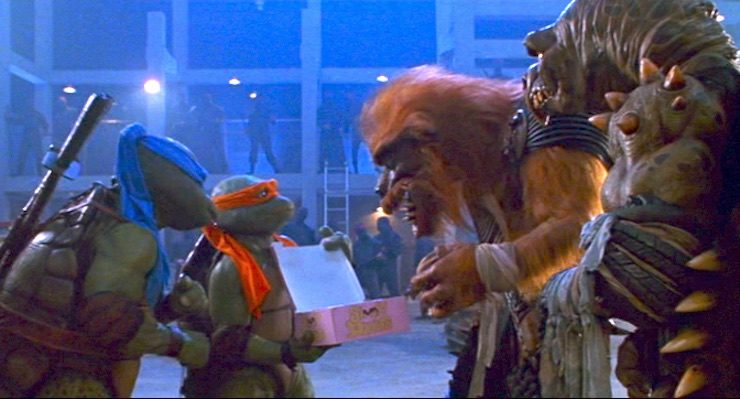
Teenage Mutant Ninja Turtles II: The Secret of the Ooze
Written by Todd W. Langen
Directed by Michael Pressman
Produced by Kim Dawson, David Chan, & Thomas K. Gray
Original release date: March 22, 1991
The turtles and Splinter are living in O’Neill’s new apartment until they can find a new place to dwell, since their sewer hideout was pretty much burned.
They make a pizza order—this time from Roy’s Pizza instead of Domino’s, meaning (a) the turtles have realized that they weren’t getting the best possible pizza in New York, which is pretty much anyplace other than Domino’s and (b) Domino’s didn’t pay to have their “pizza” featured in the film—and the delivery guy, Keno, discovers some thieves. A skilled martial artist, Keno is able to take on some of them, but they start to overwhelm him. Luckily, that’s when the turtles show up and kick butt.
O’Neill’s latest story is about Techno-Global Research Industries, which is disposing of their radioactive samples due to concerns about a leak. (They found some dandelions that are the size of sunflowers.) Raphael doesn’t want to watch O’Neill’s interview with Professor Jordan Perry of TGRI, but it is Splinter who insists on leaving it on.
Shredder survived the events of the last film, and takes control of the Foot once again. O’Neill’s camera operator is a Foot operative, and he brings one of the mutant dandelions to Shredder. He orders the Foot to kidnap Perry.
When O’Neill comes home, Splinter reveals that the canister of ooze that mutated Splinter and all four turtles had the TGRI logo on it. The turtles head to TGRI to talk to Perry, only to find that the Foot has gotten there first. Fisticuffs ensue, but the Foot get away with both the final canister of ooze that Perry had been about to dispose of as well as Perry himself.
Worried about danger to O’Neill, the turtles seek out a new place to live, and wind up in the old abandoned City Hall subway station. Keno insinuates himself into the group, and offers to infiltrate the Foot—they’re actively recruiting teenagers, particularly ones with martial arts skills—but Splinter refuses to endanger Keno.
After again arguing with Leonardo, Raphael leaves the group and joins up with Keno to enact his plan. Keno is the perfect recruit, and he’s brought to their hideout in a garbage dump. Unfortunately, Tatsu discovers them, and a fight breaks out. Raphael holds off the Foot while Keno escapes to warn the others.
At Shredder’s instruction, Perry has used the ooze on a snapping turtle and a wolf, who are mutated into human-sized creatures named Tokka and Rahzar—and who are also dumb as posts, to Shredder’s annoyance.
Keno and the three turtles go to rescue Raphael, at which they succeed, and also rescue Perry, but they’re unable to defeat Tokka and Rahzar. They regroup at their new hideout, and Perry reveals that the creation of the ooze was an accident. He also deliberately made the formula that mutated Tokka and Rahzar such that they would be spectacularly stupid.
Shredder has Tokka and Rahzar trash an entire neighborhood, and Shredder has O’Neill’s camera operator tell O’Neill that they’ll keep doing that unless the turtles meet him at his hideout. Perry, though, has created an antidote, which the turtles bring with them to the meet. After a few false starts, the turtles are able to feed the antidote to the monsters, reverting them to a wolf and snapping turtle once again. Meanwhile, the fight against the Foot takes them to a dance club, where Vanilla Ice is playing. (Don’t worry if you don’t know who that is. By the time this movie aired, the fourth-rate rapper was already well into his fifteenth minute.)
There’s one vial of ooze left, and Shredder takes it himself. His fight against the turtles continues out of the club and onto the pier, which Shredder then trashes—a tactical error, as turtles are amphibious, so they don’t drown, but Shredder does, having in essence defeated himself.
Perry sends a thank-you to the turtles via O’Neill, and Splinter chastises the turtles for being seen by an entire club full of people—and at least one photographer, since they’re on the front page of the New York Post. But then Splinter makes another funny…
“This is really gonna screw up history…”
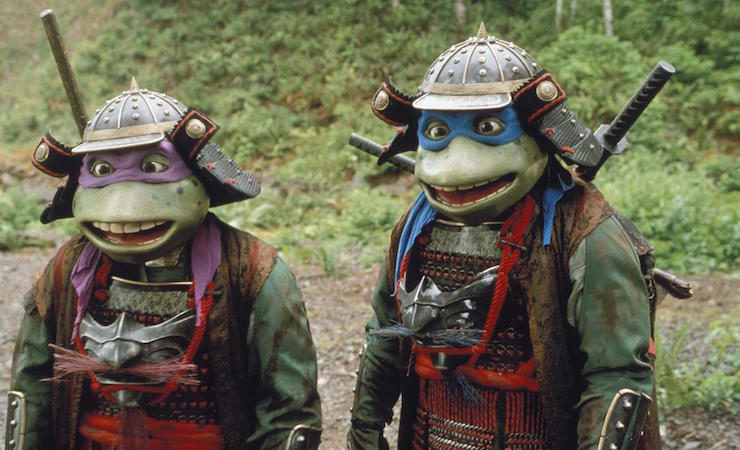
Teenage Mutant Ninja Turtles III
Written and directed by Stuart Gillard
Produced by Kim Dawson, David Chan, & Thomas K. Gray
Original release date: March 19, 1993
In feudal Japan, a young man named Kenshin is being chased by soldiers of his father, a feudal lord, or daimyo, named Norinaga. Kenshin is in league with Mitsu, a woman who leads a rebellion against Norinaga’s rule. For his part, Norinaga has entered a partnership with a British pirate named Walker, who offers guns and cannon to aid in Norinaga’s conquest goals.
In the present, O’Neill shows up at the turtles’ old subway station home. She’s about to go on vacation, but she got presents for each turtle from an antique shop. She also got something for Splinter: a scepter with Japanese writing on it.
In the past, Kenshin is captured and brought to his father. He is not imprisoned, but he is confined to the castle. He trashes a room in anger, and comes across a scepter—the very same one O’Neill bought.
The scepter starts to activate in both times, and O’Neill and Kenshin wind up trading places, with O’Neill now in a 16th-century Japanese castle and Kenshin in a 20th-century abandoned New York City subway.
O’Neill is considered to be some kind of witch—especially when Norinaga gets a load of her Walkman—and she’s imprisoned. In another cage is Whit, a guy who’s a dead ringer for Jones.
In the present, Jones arrives at the subway station. His job is to protect Splinter while the turtles use the scepter to go back in time and get O’Neill back. The turtles wind up in the middle of a battle and wearing armor. Meanwhile, four of Norinaga’s soldiers come to the present in their underwear.
While the turtles can handle themselves in a fight, they’re less skilled in riding horses. Michelangelo winds up separated from the group with the scepter, and he’s ambushed. The other three head to the castle, using their armor as cover, since it identifies them as Norinaga’s honor guard.
Raphael, Donatello, and Leonardo manages to spring O’Neill, and also Whit, and they escape the castle. They’re ambushed by Mitsu’s rebels, but then Mitsu realizes that they look just like their prisoner. They soon realize that Michelangelo is with Mitsu, and everyone becomes good friends as Mitsu takes them to her village. The turtles reassure her that Kenshin is safe in the future and they’ll send him home once they locate the scepter.
Walker attacks the village, looking for the scepter. The turtles drive him off, but Walker sets fire to several buildings. Michelangelo saves a young boy named Yoshi from a fire, and Leonardo uses CPR to save the boy’s life. Later, Raphael befriends Yoshi, convincing him to enjoy childhood by playing with kites and such rather than learn how to fight at such a young age.
In the present, Jones keeps Kenshin and the four honor guard busy by teaching them about hockey. There’s a 60-hour time limit on the turtles’ time travel—if they don’t come back before then, they never will—and Splinter and Jones are worried.
Yoshi reveals that the scepter is hidden in the village. Mitsu and the village elder reveal that they hid it because they didn’t want to lose the turtles’ fighting skills against Norinaga, who, she has learned, will attack the village with Walker’s guns in the morning.
Whit turns out to be a spy for Walker. He captures both the scepter and Mitsu and takes them back to Norinaga’s castle. The turtles storm the castle and battle Norinaga’s forces, with Leonardo and Norinaga having a sword duel.
Walker tries to escape, tossing the scepter as a distraction. However, Walker also condemned Whit to death, which Whit doesn’t much appreciate, so he uses a catapult to send Walker to his doom while the turtles retrieve the scepter.
Michelangelo and Raphael don’t want to go home—they like it better in feudal Japan where they’re actually appreciated—but Kenshin forces their hand by activating the scepter in the present. The five of them return to the present, while the four honor guard and Kenshin return to the past, the latter happily reunited with Mitsu.
The turtles celebrate their victory, with Splinter making one last funny.
“This is absolutely the worst rescue I’ve ever had!”
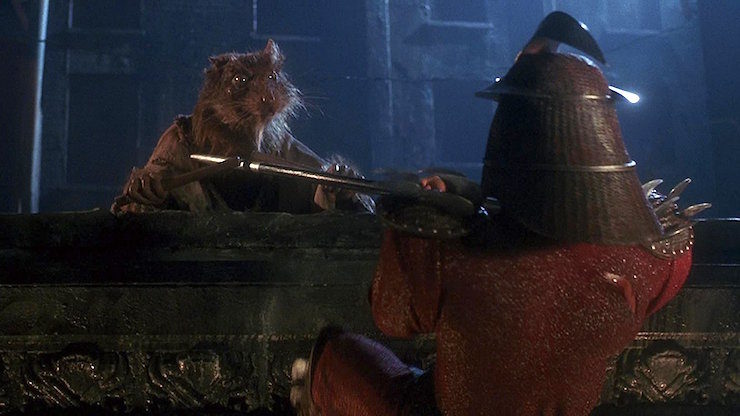
One of the things that most impressed me about the first TMNT movie when I saw it in the theatre back in 1990 was how incredibly true to the comics it was.
This is no small accomplishment. As we’ve seen quite a bit in this rewatch, the notion of a faithful adaptation to the comics is not particularly common in 20th-century comics adaptations. There were almost always significant variations, many to the point where the characters are barely recognizable.
So to see TMNT hew so closely to Kevin Eastman and Peter Laird’s comic book storylines was a revelation. This was the first time I’d seen so faithful an adaptation of a comic book.
Looking back on it and its sequels some two-and-a-half decades later, that’s not the same kind of impressive as it was then. But the movies are still as much fun to my 48-year-old self as they were to me in my 20s, despite being horribly dated. The turtles make several pop-culture references that would go over the heads of most folks who weren’t alive in the early 1990s, and there are moments, particularly in The Secret of the Ooze, where the turtles spend too much time goofing off when they should be in the middle of a fight. The worst offender is the club scene in Ooze with Vanilla Ice (a performer about whom I have not dedicated a single brain cell since about 1993 or so), but you see it throughout the three films, and while it can be cute, it grows tiresome.
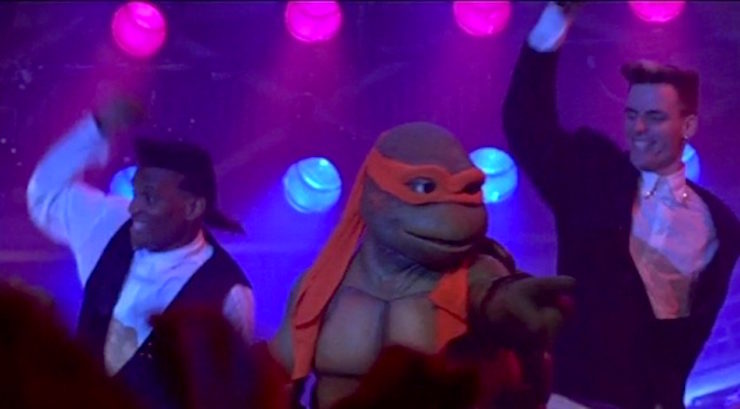
The biggest problem is that not enough is done to differentiate the turtles from each other, with the notable exception of Raphael. His surly act stands out from the other three—literally in the first two, as he storms off in a huff in both movies, and in each case it moves the plot along—which is good, as it becomes very difficult to tell the others apart from each other, despite each having their own set of weapons (how they were differentiated in the original black-and-white comic book) and a different-colored bandana/mask (first set up in the cartoon). Josh Pais gets some credit here, as his vocal work on Raphael in the first movie does a lot to set the surliest of our heroes apart—and both Laurie Faso and Tim Kelleher basically impersonated Pais when they took over for the other two films.
The third movie is often the forgotten one—the first one is, well, the first one, and the second one is mostly The One With Vanilla Ice Oh God What Were They Thinking?—but the third one has its charms. In particular, the fight choreography is far better in the third movie than the other two, as the animatronic turtles—who were done by All Effects Company instead of the Henson Creature Shop like the first two—perform actual martial arts moves in their fights.
Not to dis the Henson folks, as they did superlative work here. These turtles are far more tangible and integrated into the real world. As good as the CGI is in the 2010s films (and it’s quite excellent), it doesn’t feel as tactile and real as the animatronic turtles in these three movies. There’s a level of expressiveness and weight that CGI is much better at now than it was even ten years ago, but it’s still not there yet.
In any case, these are not great movies by any stretch of the imagination, but dammit, they’re fun. Neither Judith Hoag nor Paige Turco stand out all that much as O’Neill—Hoag is stronger than Turco, which is not something I’d say normally, as Turco’s career is much more impressive on the whole—but Elias Koteas is having a grand old time as Jones, and it’s infectious, for all that he’s a complete jerk. (Also the kiss between him and O’Neill at the end of the first movie is horribly contrived, as there’s nothing in the film to justify it. Jones is an ass, and they only kiss because it’s a movie and that’s what’s supposed to happen.) Jones’s presence was missed in Ooze, with Keno a mediocre substitute, blandly played by Ernie Reyes Jr.
Plus, we’ve got a few Robert Knepper moments here: Kevin Clash—the voice of Elmo his own self—does Splinter’s voice in the first two films, and Sam Rockwell plays one of Shredder’s thugs in the first movie, and yes, that’s really Corey Feldman as the voice of Donatello in the first and third.
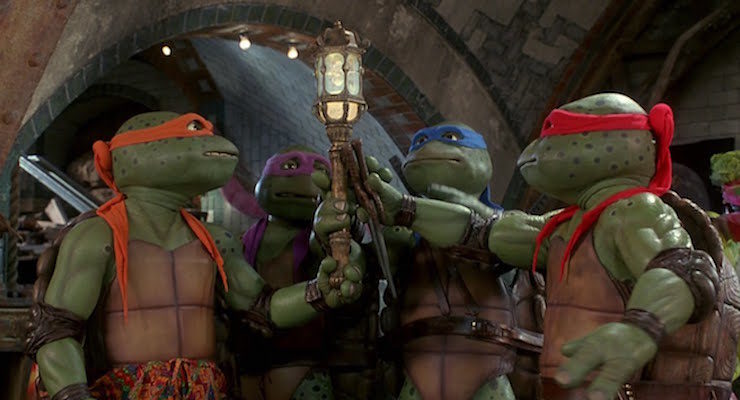
Next week, in anticipation of the release of Netflix’s Marvel’s The Punisher, we’ll take a gander at the three previous attempts to bring the Punisher to the screen.
Keith R.A. DeCandido will be the special guest at the Providence Literary Festival in Providence, Kentucky this weekend, one of the author guests at Philcon 2017 in Cherry Hill, New Jersey next weekend, and the Author Guest of Honor at Atomacon 2017 in North Charleston, South Carolina the weekend after that. Come on by and say hi!










